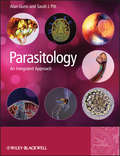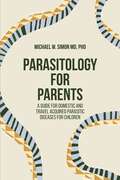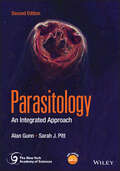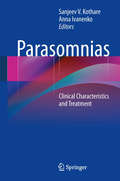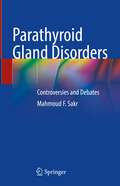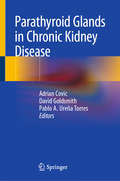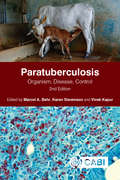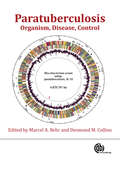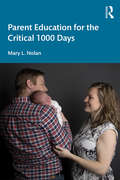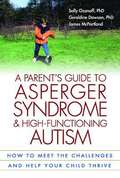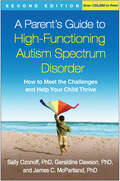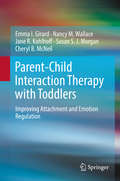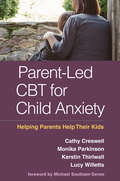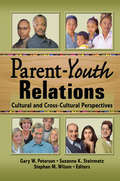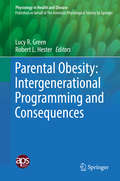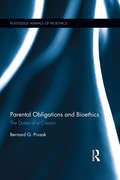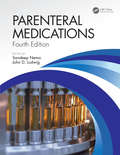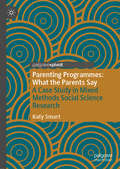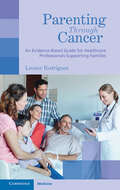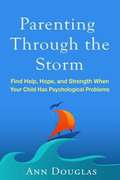- Table View
- List View
Parasitology
by Sarah Jane Pitt Alan GunnParasitology: An Integrated Approach, provides a concise, student-friendly account of parasites and parasite relationships that is supported by case studies and suggestions for student projects. The book focuses strongly on parasite interactions with other pathogens and in particular parasite-HIV interactions, as well as looking at how host behaviour contributes to the spread of infections. There is a consideration of the positive aspects of parasite infections, how humans have used parasites for their own advantage and also how parasite infections affect the welfare of captive and domestic animals. The emphasis of Parasitology is on recent research throughout and each chapter ends with a brief discussion of future developments. This text is not simply an updated version of typical parastitology books but takes an integrated approach and explains how the study of parasites requires an understanding of a wide range of other topics from molecular biology and immunology to the interactions of parasites with both their hosts and other pathogens.
Parasitology for Parents: A Guide for Domestic and Travel Acquired Parasitic Diseases for Children
by Michael W. SimonThis book is a handy and necessary resource that reviews the risks of exposure to parasitic illnesses from domestic and international travel with specific relevant information about their transmission, symptoms and treatment. This is Dr. Simon'
Parasitology: An Integrated Approach (New York Academy of Sciences)
by Alan Gunn Sarah J. PittParasitology Highly detailed textbook on parasites and parasite relationships The fully revised edition of Parasitology: An Integrated Approach holds true to its engaging and easy-to-read approach. It comprehensively covers the complex and dynamic interaction between the parasite and its host ranging from invertebrates to vertebrates. Following an integrated approach, the authors explain how the study of parasites requires an understanding of biological concepts such as growth and reproduction, molecular biology, biochemistry, immunology, and pathology. In this second edition, they further address parasites and parasite relationships in the grand scheme of global changes and their impact. This textbook also reviews the often-neglected positive aspects of parasite infections and how humans have used parasites for their own advantage. Parasitology: An Integrated Approach, 2nd edition includes supplementary learning resources such as self-assessment quizzes, practical exercises, and an extensive collection of photographs. Now includes parasite life cycles in colour Strong focus on parasite interactions with other pathogens such as bacteria and viruses Discusses major advancements in the field of parasite diagnostics Additional image material and learning resources (quizzes, practical exercises) provided online A valuable and comprehensive learning resource for undergraduate students in the biological, biomedical and veterinary sciences and in medicine. It is also of interest to postgraduates and professionals with an interest including but not limited to parasitology, animal welfare, ecology, and medical microbiology.
Parasitology: An Integrated Approach (Wiley Desktop Editions Ser.)
by Sarah Jane Pitt Alan GunnParasitology: An Integrated Approach, provides a concise, student-friendly account of parasites and parasite relationships that is supported by case studies and suggestions for student projects. The book focuses strongly on parasite interactions with other pathogens and in particular parasite-HIV interactions, as well as looking at how host behaviour contributes to the spread of infections. There is a consideration of the positive aspects of parasite infections, how humans have used parasites for their own advantage and also how parasite infections affect the welfare of captive and domestic animals. The emphasis of Parasitology is on recent research throughout and each chapter ends with a brief discussion of future developments. This text is not simply an updated version of typical parastitology books but takes an integrated approach and explains how the study of parasites requires an understanding of a wide range of other topics from molecular biology and immunology to the interactions of parasites with both their hosts and other pathogens.
Parasomnias: Clinical Characteristics and Treatment
by Sanjeev V. Kothare Anna IvanenkoParasomnias are phenomena that occur exclusively during sleep or are exacerbated during sleep/wake transition. These disorders are known to contribute towards impaired quality of life, disturbed and non-restorartive sleep, risk for injuries to self and others, and often associated with other medical, neurological, and psychiatric disorders. Advances in sleep medicine have revealed a high prevalence of parasomnias across all ages. With the growing interest for diagnosing and management of parasomnias in sleep medicine, a practical guide to parasomnias is greatly needed. Parasomnias provides a comprehensive review of epidemiology, pathophysiology, clinical characteristics, diagnostic evaluation and treatment of parasomnias across the patient's life span. Written by experts, each chapter integrates the latest research and clinical data. In addition, several chapters address medico-legal and forensic aspects of parasomnias. Clinicians and researchers with an interest in sleep medicine will find Parasomnias to not only be an important contribution to the literature, but an indispensible guide to identifying, understanding and treating this disorder.
Parathyroid Gland Disorders: Controversies and Debates
by Mahmoud F. SakrThe book offers a comprehensive overview of all parathyroid gland disorders both, benign and malignant. It emphases established concepts, presents the ongoing controversies, challenges and debates on diagnosis and treatment of different parathyroid gland disorders, with a view of clarifying some uncertainties, making suggestions to resolve others, and establishing strategies to reach therapeutic success.In addition to general information on parathyroid gland embryology, surgical anatomy, histology and physiology, the chapters explore hyperparathyroidism, osteitis fibrosa cystica, hypoparathyroidism, hungry bone syndrome, the importance of calcium in the human body and differential diagnosis of hypercalcemia. The last chapters investigate post-thyroidectomy hypocalcemia, thyroid cancer, recent intra-operative localizing tools, and illustrate new techniques of parathyroidectomy, as well as parathyroid transplantation. The book will be an invaluable and indispensable source of knowledge and reference for all specialists and trainees entrusted with the care of patients suffering from parathyroid disease.
Parathyroid Glands in Chronic Kidney Disease
by David Goldsmith Adrian Covic Pablo A. Ureña TorresThis concise book provides practical strategies to help nephrologists and endocrinologists correctly diagnose and treat the various forms of parathyroid disease they may encounter in the management of chronic kidney disease. Each chapter deals with various topics related to parathyroid gland anatomy and physiology, as well as diagnostic tests and their particularities in regard to chronic disease. The book highlights the range of therapies used for the treatment of secondary hyperparathyroidism, and critically analyses the latest research in the field. Providing an up-to-date review of the current literature, including innovations in both medical and surgical treatment and current indications for parathyroidectomy, this practice-oriented book is an excellent resource for nephrologists, endocrinologists, endocrine surgeons and family medicine physicians.
Paratuberculosis: Organism, Disease, Control
by Ian Marsh Richard Whittington John P. Bannantine Rory O'Brien Ali Thompson David C Alexander Angelika Agdestein Christina Ahlstrom Herman W. Barkema Raul Barletta Douglas Begg Marcel Behr Evan P. Brenner Tim Bull Ofelia Chacon Paul Coussens Ross S. Davidson Justin L. DeKuiper Kumudika De Silva Berit Djonne Karsten Donat Shannon Duffy Natalia Elguezabal Susanne Eisenberg Naomi J. Fox Joseba M. Garrido Irene R. Grant J Frank Griffin Murray Hines II Michael R Hutchings Jamie Imada Ramón A. Juste Edward Kabara Annette H. Kampen David F. Kelton Jennifer N. Kiser Elise A. Lamont Kari R. Lybeck Colin Mackintosh Glenn Marion Holly L Neibergs Søren Saxmose Nielsen Karren M. Plain Auriol Purdie Govardhan Rathnaiah Iker A. Sevilla Fernanda M. Shoyama Lesley A. Smith Srinand Sreevatsan Judy Stabel Jaryd R. Sullivan Adel Talaat Girum T. Tessema Christine Turenne Chia-Wei Wu Denise K. ZinnielParatuberculosis, also referred to as Johne's disease, affects principally cattle, goats, sheep, buffalo, deer and other ruminants. It is common worldwide and responsible for significant economic losses in the ruminant livestock industries. A timely follow up to the first book on Paratuberculosis, this new edition is still the only comprehensive text providing both historical context and the latest developments in the field. Examining the epidemiology of paratuberculosis, the organism that causes the disease, and practical aspects of its diagnosis and control, it also addresses the link between paratuberculosis in the food chain and human health implications, including Crohn's disease. This new edition: · Builds on a strong foundation to update, streamline and better structure existing chapters with important new developments from the last decade, such as whole genome sequencing and phage-based assays; · Includes new chapters on the fast-growing field of whole genome based comparative genomics, and the increasing opportunities for disease control in low- and middle-income countries; · Increases inclusivity by bringing on board new rising star authors from diverse backgrounds to provide international perspectives. A truly comprehensive, critical reference resource, this book is an essential reference for large animal veterinarians, livestock industry personnel and those involved in the dairy and meat industries, as well as microbiologists, researchers and students in these fields.
Paratuberculosis: Organism, Disease, Control
by Marcel A. Behr Desmond M. CollinsThis book examines the epidemiology of paratuberculosis, the organism that causes the disease, and practical aspects of its diagnosis and control. It also addresses the link between paratuberculosis in the food chain and human health implications, including Crohn's disease. This text is an essential resource for large animal veterinarians, livestock industry personnel and those involved in the dairy and meat industries, as well as microbiologists, researchers and students in these fields.
Parent Education for the Critical 1000 Days
by Mary L. NolanAs research in neuroscience increasingly points to the unparalleled influence of the first 1000 days of life from conception to two years of age in determining the baby’s life trajectory, the need for high-quality early parenting education delivered by knowledgeable and dedicated professionals becomes ever more apparent. This book describes the global aims of early parenting education. It identifies the key areas that research suggests are important: building a relationship with the unborn and newborn baby; preparing for labour and birth; supporting parents’ mental health; protecting the couple relationship across the transition to parenthood; and education for special groups such as same-sex couples, women with fear of birth, prisoners, military wives and parents from black and minority ethnic backgrounds. All practitioners providing early parenting programmes – midwives, health visitors, family link workers, children’s centre staff and voluntary sector teachers – will gain new ideas for their practice in this book. Students taking midwifery and early childhood courses will find much to support their studies. Ultimately, the book provides inspiration for all those who are committed to the role of parenting education in reducing social inequalities.
Parent's Guide to Asperger Syndrome and High-Functioning Autism
by Sally Ozonoff Geraldine DawsonAsperger Syndrome and high-functioning autism are detected earlier and more accurately today than ever before. Children and teens with these disorders often stand out for their precocious intelligence and language abilities--yet profound social difficulties can limit every aspect of their lives. This hopeful, compassionate guide shows parents how to work with their child's unique impairments and capabilities to help him or her learn to engage more fully with the world and live as self-sufficiently as possible. From leading experts in the field, the book is packed with practical ideas for helping children relate more comfortably to peers, learn the rules of appropriate behavior, and participate more fully in school and family life. It also explains what scientists currently know about autistic spectrum disorders and how they are diagnosed and treated. Real-life success stories, problem-solving ideas, and matter-of-fact advice on everything from educational placements to career planning make this an indispensable reference that families will turn to again and again.
Parent's Guide to High-Functioning Autism Spectrum Disorder, Second Edition: How to Meet the Challenges and Help Your Child Thrive
by Sally Ozonoff Geraldine Dawson James C. McpartlandMany tens of thousands of parents have found the facts they need about high-functioning autism spectrum disorder (ASD), including Asperger syndrome, in this indispensable guide. Leading experts show how you can work with your child's unique impairments--and harness his or her capabilities. Vivid stories and real-world examples illustrate ways to help kids with ASD relate more comfortably to peers, learn the rules of appropriate behavior, and succeed in school. You'll learn how ASD is diagnosed and what treatments and educational supports really work. Updated with the latest research and resources, the second edition clearly explains the implications of the DSM-5 diagnostic changes.
Parent-Child Interaction Therapy with Toddlers: Improving Attachment and Emotion Regulation
by Emma I. Girard Nancy M. Wallace Jane R. Kohlhoff Susan S. Morgan Cheryl B. McNeilThis book presents an early treatment model for toddlers. It describes the early life span development, trajectory, and future potential of toddlers and how it may be powerfully influenced by the protection and guidance of caregivers to meet toddlers’ physical and mental health needs. It offers an in-depth guide toParent-Child Interaction Therapy with Toddlers (PCIT-T), an evidence-based program for addressing and preventing behavior problems affecting young children’s development. The book details the innovative intervention design and how it guides clinicians in providing treatment for 12-month old to 24-month old toddlers with disruptive behaviors in addition to being used as a prevention model for caregivers experiencing stress of child rearing. PCIT-T focuses on core areas of social and emotional development, including behavior management and language skills, and can be used in dealing with difficulties as diverse as tantrums, language issues, autistic behaviors, and separation anxiety. Play therapy and compliance training in child-directed as well as parent-directed sessions are also examined. Initial chapters provide an overview of attachment and behavioral theory components that are foundational to the treatment model. Subsequent chapters provide a session-by-session guide and clinical manual for implementation of PCIT-T as well as the clinician tools needed to monitor treatment integrity and fidelity to the model. Topics featured in this book include:Core elements and treatment goals of PCIT-TA range of behavioral assessments used in PCIT-T.Instructions for room set-up, toy selection, and special considerations when providing PCIT-T treatment.Preparation guides for the pretreatment interview, assessment sessions, and weekly coaching sessions.The importance of child-directed interaction toddler (CDI-T) and parent-directed interaction toddler (PDI-T) in teaching children the necessary skills to regulate their emotions and develop self-control. Parent-Child Interaction Therapy with Toddlers is a must-have resource for clinicians and related professionals, researchers and professors, and graduate students in the fields of clinical child and school psychology, social work, pediatrics, infancy and early childhood development, child and adolescent psychiatry, primary care medicine, and related disciplines.
Parent-Child Separation: Causes, Consequences, and Pathways to Resilience (National Symposium on Family Issues #1)
by Valarie King Susan M. McHale Jennifer E. GlickThis book examines the similarities in children’s short- and long-term development and adjustment when they have been separated from their parents because of larger institutional forces. It addresses the unique circumstances and the similarities faced by parents and children under three different institutional contexts of separation: parental migration and deportation, parental incarceration, and parental military deployment. Chapters describe the difficulties faced by families in each of these circumstances, along with the challenges in conducting research under the multidimensional and dynamic complexities of parent-child separation. Finally, the volume offers recommendations for creating supportive structures and interventions for families facing separation that can bolster youth well-being in childhood and beyond.Featured areas of coverage include:· Parental migration.· Parental incarceration.· Parental military deployment.· Undocumented migration and deportation.· Child-parent relationship and child resilience and adjustment.Parent-Child Separation is a must-have resource for researchers, professors, clinicians, professionals, and graduate students in developmental psychology, family studies, public health, clinical social work, educational policy, and migration studies as well as all interrelated disciplines, including sociology, criminology, demography, prevention science, political science, and economics.
Parent-Led CBT for Child Anxiety: Helping Parents Help Their Kids
by Monika Parkinson Lucy Willetts Kerstin Thirlwall Cathy CreswellParents can play a strong role in helping their children overcome anxiety disorders--given the right tools. This innovative, research-based book shows clinicians how to teach parents cognitive-behavioral therapy (CBT) techniques to use with their 5- to 12-year-old. Session-by-session guidelines are provided for giving parents the skills to promote children's flexible thinking and independent problem solving, help them face specific fears, and tackle accompanying difficulties, such as sleep problems and school refusal. User-friendly features include illustrative case studies, sample scripts, advice on combining face-to-face sessions with telephone support, and pointers for overcoming roadblocks. Several parent handouts can be downloaded and printed in a convenient 8 1/2" x 11" size.
Parent-Youth Relations: Cultural and Cross-Cultural Perspectives
by Gary W Peterson Suzanne Steinmetz Stephan WilsonExplore the most fundamental human relationship-between parent and childWestern social science has long neglected to acknowledge that family relationships must always be examined from a culturally sensitive perspective. Parent-Youth Relations: Cultural and Cross-Cultural Perspectives fills this void by exploring in depth the most fundamental human relationship-between parent and child-in different societies around the world. International experts provide a comprehensive collection of original research and theory on how parental styles and the effects of culture are interconnected. Written from diverse perspectives, this unique resource reveals deep insight into these relationships by focusing on the individuals, the structure of the family, and societal and cultural influences. Parental relations and cultural belief systems both play integral parts on how socialization and development occur in children. Parent-Youth Relations: Cultural and Cross-Cultural Perspectives presents several viewpoints, some comparing similarities and differences across societies or nations, others exploring relationships within a single culture. This probing global look at parent-youth relations provides sensitively nuanced information valuable for every professional or student in the social sciences. Detailed tables illustrate research data while thorough bibliographies offer opportunities for further study.Parent-Youth Relations: Cultural and Cross-Cultural Perspectives explores: parenting style and its effects on children in Chinese culture parenting style in problem-solving situations in Hong Kong cross-national perspectives on parental acceptance-rejection theory multinational studies of interparental conflict, parenting, and adolescent functioning the relationship between parenting behaviors and adolescent achievement in Chile and Ecuador parent-adolescent relations and problem behaviors in Hungary, the Netherlands, Switzerland, and the United States cross-national analysis of family and school socialization and adolescent academic achievement parent-child contact after divorce-from the child&’s perspective familial impacts on adolescent aggression and depression in Colombia predicting Korean adolescents&’ sexual behavior from individual and family factors parenting in Mexican society relations with parents and friends during adolescence and early adulthood parent-child relationships in childhood and adulthood and their effect on the parent&’s marriage the effects of financial hardship, interparental conflict, and maternal parenting in Germany and more original research studies! Parent-Youth Relations: Cultural and Cross-Cultural Perspectives presents the freshest research available along with extensive bibliographies, providing essential reading for educators, advanced undergraduates, graduate students, and professionals in family studies, sociology, psychology, and anthropology.
Parental Life Courses after Separation and Divorce in Europe (Life Course Research and Social Policies #12)
by Michaela Kreyenfeld Heike TrappeThis open access book assembles landmark studies on divorce and separation in European countries, and how this affects the life of parents and children. It focuses on four major areas of post-separation lives, namely (1) economic conditions, (2) parent-child relationships, (3) parent and child well-being, and (4) health. Through studies from several European countries, the book showcases how legal regulations and social policies influence parental and child well-being after divorce and separation. It also illustrates how social policies are interwoven with the normative fabric of a country. For example, it is shown that father-child contact after separation is more intense in those countries which have adopted policies that encourage shared parenting. Correspondingly, countries that have adopted these regulations are at the forefront of more egalitarian gender role attitudes. Apart from a strong emphasis on the legal and social policy context, the studies in this volume adopt a longitudinal perspective and situate post-separation behaviour and well-being in the life course. The longitudinal perspective opens up new avenues for research to understand how behaviour and conditions prior or at divorce and separation affect later behaviour and well-being. As such this book is of special appeal to scholars of family research as well as to anyone interested in the role of divorce and separation in Europe in the 21st century.
Parental Obesity: Intergenerational Programming and Consequences
by Lucy R. Green Robert L. HesterIn this book, leading figures in the field of Developmental Origins of Health and Disease provide up-to-date information from human clinical trials, cohorts, and animal physiology experiments to reveal the interdependence between parental obesity and health of the offspring. Obesity of the mother and father produces obesity in their offspring, so we are caught up in an intergenerational cycle, which means that even our children's future health is in peril. This book gives a timely and much-needed synthesis of the mechanisms, potential targets of future interventions, and the challenges that need to be overcome in order to break the intergenerational cycle of obesity. This has profound implications for the way in which scientific, clinical and health policy activities are to be directed in order to combat the so-called epidemic of obesity, as well as diabetes, cancer and cardiovascular disease. The book will be of interest to students, clinicians, researchers and health policy makers who are either seeking an introduction to the area of Developmental Origins of Health and Disease or have a specific interest in the pathogenesis of obesity.
Parental Obligations and Bioethics: The Duties of a Creator (Routledge Annals of Bioethics #14)
by Bernard G. PrusakThis book examines the question of what parental obligations procreators incur by bringing children into being. Prusak argues that parents, as procreators, have obligations regarding future children that constrain the liberty of would-be parents to do as they wish. Moreover, these obligations go beyond simply respecting a child’s rights. He addresses in turn the ethics of adoption, child support, gamete donation, surrogacy, prenatal genetic enhancement, and public responsibility for children.
Parenteral Medications, Fourth Edition
by Sandeep Nema John D. LudwigParenteral Medications is an authoritative, comprehensive reference work on the formulation and manufacturing of parenteral dosage forms, effectively balancing theoretical considerations with practical aspects of their development. Previously published as a three-volume set, all volumes have been combined into one comprehensive publication that addresses the plethora of changes in the science and considerable advances in the technology associated with these products and routes of administration. Key Features: Provides a comprehensive reference work on the formulation and manufacturing of parenteral dosage forms Addresses changes in the science and advances in the technology associated with parenteral medications and routes of administration Includes 13 new chapters and updated chapters throughout Contains the contributors of leading researchers in the field of parenteral medications Uses full color detailed illustrations, enhancing the learning process The fourth edition not only reflects enhanced content in all the chapters but also highlights the rapidly advancing formulation, processing, manufacturing parenteral technology including advanced delivery and cell therapies. The book is divided into seven sectionss: Section 1 - Parenteral Drug Administration and Delivery Devices; Section 2 - Formulation Design and Development; Section 3 - Specialized Drug Delivery Systems; Section 4 - Primary Packaging and Container Closure Integrity; Section 5 - Facility Design and Environmental Control; Section 6 - Sterilization and Pharmaceutical Processing; Section 7 - Quality Testing and Regulatory Requirements
Parenting Bright Kids Who Struggle in School: A Strength-Based Approach to Helping Your Child Thrive and Succeed
by Dewey RosettiParenting Bright Kids Who Struggle in School guides parents through the challenging and often unfamiliar landscape of raising kids who have been labeled with learning differences, including dyslexia, ADHD, autism, sensory processing disorder, and more. This book:Builds upon Harvard professor Todd Rose's groundbreaking research in the "Science of Individuality."Helps parents target their child's jagged profile of strengths and weaknesses.Explains a child's context of learning and multiple pathways.Teaches revolutionary techniques to encourage strengths and mitigate weaknesses.Helps parents manage the emotional fallout of raising a child who does not conform to the "average" model of learning.Drawing from her own experience as a parent of a child with learning differences—who is now a highly successful adult—the author outlines clear lessons from a quarter century of advocating for kids who learn differently.
Parenting Programmes: A Case Study in Mixed Methods Social Science Research
by Katy SmartThis book presents original research examining parents’ perspectives on the structure, content and delivery of parenting programmes. It explores how parents have personally been impacted by attending such a programme and finally whether or not this might be affecting their child. Utilising an innovative mixed methods research approach, based around a critical realist philosophy, the author follows 136 families through one of three parenting programmes and beyond. In doing so, she provides important new insights regarding the efficacy of the parenting programmes, demonstrating a real-world application of the transplant model of parent-professional practice in action.This book provides a valuable new resource for students and scholars working in the psychology of education, education, childhood studies, and across the social sciences more broadly. It will also be of interest to policymakers and professionals involved in the development and implementation of parenting programmes.
Parenting Through Cancer: An Evidence-Based Guide for Healthcare Professionals Supporting Families
by Leonor RodriguezExperiencing a parent or guardian with cancer is extremely difficult for children and adolescents with healthcare professionals and cancer support centres often lacking the specialised knowledge needed to also support these individuals. This practical guide provides a comprehensive and current understanding of the impact of parental cancer on children, young people and families. It offers a longitudinal account of the impact of cancer through the different stages of the illness and explores the impact of culture and international contexts on how families experience parental cancer. The book also crucially focuses on how to support children, young people and families by examining existing interventions. Important chapters on death and bereavement, and on self-care for practitioners also supplement the book. A valuable handbook for healthcare practitioners from a range of specialities working with patients and families affected by cancer, including clinical psychology, counselling, nursing, oncology, palliative care and social work.
Parenting Through the Storm: Find Help, Hope, and Strength When Your Child Has Psychological Problems
by Ann DouglasRaising a child or teenager with a psychological condition is a "perfect storm" of stress, sadness, and uncertainty. How can you find the best treatments and help your child overcome emotional, behavioral, and academic challenges--while keeping yourself and your family strong? As a parent, you may feel isolated and alone, but the reality is that a lot of families are in the same boat. Ann Douglas knows firsthand just how daunting it can be. In this compassionate and empowering guide, she combines the vital lessons she has learned with vivid stories from other parents and advice from leading psychologists. Several record-keeping forms can be downloaded and printed for repeated use. The book cuts through the often-confusing clinical jargon and speaks from the heart about what matters most: the well-being of your child.
Parenting and Couple Relationships Among LGBTQ+ People in Diverse Contexts
by Normanda Araujo de Morais Fabio Scorsolini-Comin Elder Cerqueira-SantosThis book analyzes how the increasing number of same-sex couples is changing the traditional concepts of family and parenthood, and how these changes affect the psychological studies of family, couple relationships and human development. The majority of chapters included in this contributed volume present results of research conducted with LGBTQ+ people in Brazil, a country where same-sex couples have been recognized by the national legislation since 2011, but is currently facing a conservative wave which threatens much of the victories gained by the LGBTQ+ movement in recent years. That’s why this book aims to provide both updated theoretical and methodological contributions as well as ethically and political engaged reflections to the field of psychological studies of LGBTQ+ parenting and couple relationships. Chapters in this volume analyze different aspects of LGBTQ+ parenting and couple relationships, such as changes in the concept of family; the role of the family of origin in the coming out process of young adults; risk and protective factors in couple relationships between lesbians and gay men; vulnerabilities experienced by trans couples during the COVID-19 pandemic; how lesbians, gays, trans and non-binaries are approaching parenting and raising their families; factors that shape the reproductive decisions of LGBTQ+ individuals; adoption and coparenting in families composed of gay and lesbian couples, among other topics. Parenting and Couple Relationships Among LGBTQ+ People in Diverse Contexts will be of interest to social, developmental and family psychologists and social workers researching and working with same-sex couples and families, and with the LGBTQ+ population in general.
